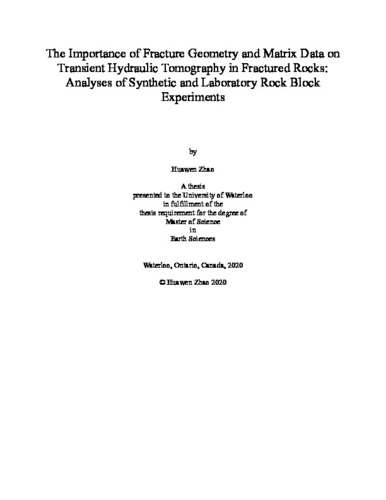| dc.contributor.author | Zhao, Huawen | |
| dc.date.accessioned | 2020-05-15 18:04:15 (GMT) | |
| dc.date.available | 2020-05-15 18:04:15 (GMT) | |
| dc.date.issued | 2020-05-15 | |
| dc.date.submitted | 2020-05-08 | |
| dc.identifier.uri | http://hdl.handle.net/10012/15870 | |
| dc.description.abstract | The accurate characterization of hydraulic properties within fractured geologic media as well as the imaging of fracture patterns and their connectivity have been difficult to accomplish over the last few decades. Recently, hydraulic tomography has been suggested as a promising approach for imaging the key hydraulic parameters such as hydraulic conductivity (K) and specific storage (Ss) distribution of fractured geologic media. This thesis investigates the importance of geologic information on HT analyses through synthetic experiments and laboratory rock block experiments conducted by Sharmeen et al. (2012). Specifically, three inverse modeling approaches with different types of geologic data included in the analyses were examined: 1) homogeneous estimates of hydraulic parameters without geologic data; 2) correct fracture locations and matrix data with correct hydraulic parameters; and 3) partially correct fracture locations and matrix data with incorrect hydraulic parameters. In this study, the assessment of transient hydraulic tomography (THT) is conducted in fractured dolomitic rock block through the Sequential Successive Linear Estimator (SSLE) developed by Zhu and Yeh (2005). The image of fracture patterns and their connectivity are presented through maps of K and Ss distributions (or tomograms). The validation of inverse modeling results is quantitatively performed through the prediction of independently conducted pumping tests not used in the calibration effort. The comparison among results obtained from different approaches indicates that: 1) THT analysis can capture the overall fracture pattern and their hydraulic properties (K and Ss), but the estimated values are higher where observations are limited; 2) using a correct geological model as prior information in a geostatistical inverse model can preserve geologic features especially within the matrix, where drawdown data are hard to obtain; 3) a simple model without any geologic information is more reliable than the one based on the wrong description of geologic features. Overall, the results from this study indicate the importance of incorporating accurate geological data in HT surveys when drawdown data are sparse and not available within the matrix, which could have critical implications for field research in fractured rock hydrogeology. | en |
| dc.language.iso | en | en |
| dc.publisher | University of Waterloo | en |
| dc.title | The Importance of Fracture Geometry and Matrix Data on Transient Hydraulic Tomography in Fractured Rocks: Analyses of Synthetic and Laboratory Rock Block Experiments | en |
| dc.type | Master Thesis | en |
| dc.pending | false | |
| uws-etd.degree.department | Earth and Environmental Sciences | en |
| uws-etd.degree.discipline | Earth Sciences | en |
| uws-etd.degree.grantor | University of Waterloo | en |
| uws-etd.degree | Master of Science | en |
| uws.contributor.advisor | Illman, Walter | |
| uws.contributor.affiliation1 | Faculty of Science | en |
| uws.published.city | Waterloo | en |
| uws.published.country | Canada | en |
| uws.published.province | Ontario | en |
| uws.typeOfResource | Text | en |
| uws.peerReviewStatus | Unreviewed | en |
| uws.scholarLevel | Graduate | en |

